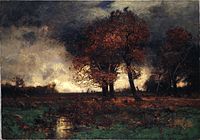| This article needs additional citations for verification. Please help improve this article by adding citations to reliable sources. Unsourced material may be challenged and removed. Find sources: "John Francis Murphy" – news · newspapers · books · scholar · JSTOR (August 2008) (Learn how and when to remove this message) |
| John Francis Murphy | |
|---|---|
 John Francis Murphy, circa 1920 John Francis Murphy, circa 1920 | |
| Born | December 11, 1853 Oswego, New York |
| Died | January 30, 1921 |
| Known for | Landscape painting |
| Style | Tonalism |
John Francis Murphy (December 11, 1853 – January 30, 1921) was an American Irish landscape painter. His style moved from poetic Tonalism to the innovative application of multiple layers of pigment, in order to create a sparse, brooding landscape, later in his career.
Biography
John Francis Murphy was born at Oswego, New York on December 11, 1853. His father, Martin Francis Murphy (1822-1899) had immigrated from Waterford to Oswego where he married Hannah Gregory (1839-1899). In 1870, he moved to Chicago and became a sign painter. After being dismissed from his job, Murphy moved to New York City where he taught himself painting, in 1875. In 1887, he built a studio in Arkville, New York and founded the Pakatakan Artist Colony.
He first exhibited at the National Academy of Design in 1876, and was made an associate in 1885 and a full academician two years later. He became a member of the Society of American Artists in 1901 and of the American Watercolor Society. At first influenced by Wyant and Inness, after 1900 he attacked the modern problems of light and air, thus combining the old and new theories of landscape painting. He received numerous awards, including a gold medal at Charleston in 1902 and the Inness medal in 1910.
He died on January 30, 1921, of pneumonia in New York City.
Gallery
-
 A Stormy Day - Brooklyn Museum
A Stormy Day - Brooklyn Museum
-
 Figure Standing in a Field
Figure Standing in a Field
Works
Representative examples of his work are:
- October (Corcoran Gallery of Art, Washington)
- The Path to the Village (National Gallery of Art, Washington)
- Indian Summer (National Gallery of Art, Washington)
- Indian Summer Oaks, 1887 (Cahoon Museum of American Art, Cotuit, Massachusetts)
- The Old Barn (Metropolitan Museum, New York)
- The Hill Top (Art Institute of Chicago)
- Afternoon Lights on the Hills (Carnegie Institute, Pittsburgh)
- Neglected Lands (Buffalo Academy)
- Twilight
- Late September
- Golden Autumn (National Cowboy & Western Heritage Museum, Oklahoma City)
- The River Farm
- Tints of a Vanished Past, awarded the 1885 Second Hallgarten Prize by the National Academy of Design.
- Golden Autumn, 1898 (Salmagundi Club, New York)
References
- "John Francis Murphy". Artsy.net. Retrieved 2022-03-01.
- "New York, U.S., State Census", United States census, 1865; Oswego, New York; roll 116, page 33, line 20.
- ^ "John Francis Murphy obit". New-York Tribune. 1921-01-31. p. 9. Retrieved 2019-11-11.
- ^ "J. Francis Murphy". Smithsonian American Art Museum. Retrieved 2019-11-11.
- "Pakatakan Artists Colony Historic District: Asset Detail". npgallery.nps.gov. Retrieved 2019-11-09.
- [REDACTED] One or more of the preceding sentences incorporates text from a publication now in the public domain: Chisholm, Hugh, ed. (1911). "Murphy, John Francis". Encyclopædia Britannica. Vol. 19 (11th ed.). Cambridge University Press. p. 38.
- National Cowboy & Western Heritage Museum
- "John Francis Murphy (1853-1921) [RA 1878-1921] : Golden autumn, 1898". salmagundi.org. January 21, 2021. Retrieved March 19, 2023.
Sources
- Cahoon Museum of American Art: https://web.archive.org/web/20120326172806/http://www.cahoonmuseum.org/american-impressionism.php
- Sherman, Frederic Fairchild, American Painters of Yesterday and Today, 1919, Priv. print in New York. Chapter: Miniature landscapes by J. Francis Murphy: https://archive.org/stream/americanpainters00sheriala#page/n17/mode/2up
External links
- Paintings by J. Francis Murphy, an exhibition catalog from The Metropolitan Museum of Art Libraries (fully available online as PDF)
- Artwork by John Francis Murphy